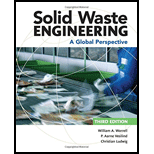
Solid Waste Engineering
3rd Edition
ISBN: 9781305635203
Author: Worrell, William A.
Publisher: Cengage Learning,
expand_more
expand_more
format_list_bulleted
Concept explainers
Question
Chapter 6, Problem 6.8P
To determine
(a)
The amount of methane gas produced on complete decomposition.
To determine
(b)
The methane produced by natural process.
Expert Solution & Answer
Trending nowThis is a popular solution!

Students have asked these similar questions
Q: Assume a rough estimate of MSW composition is as follows:
% by weight
Moisture content (%)
Paper (assume dry mass all cellulose, C6H10O5)
40
8%
Glass
10
-
Steel
10
-
Aluminum
10
-
Food waste (assume dry mass all sugar, C6H12O6)
30
80%
a) If 20,000 metric tonnes of this waste is for anaerobic digestion, how much methane gas would theoretically be produced?
b) If 20,000 metric tonnes of this waste is for aerobic composting. How much oxygen would theoretically be demanded?
Determine leachate generated in a cell in a 12-month period. You may assume that:
-Percolation through the cover is 15in
-Water consumed by waste decomposition is negligible (Life 1 contains mostly fresh waste)
-Water loss as water vapor in landfill gas is negligible (again due to fresh waste)
-Initial moisture content in fresh waste = 0.20
-Weight of waste in the lift = 3000 lb/yd²
-Weight of cover = 1500 lb/yd²
-The following sketch depicts water in and out of a waste lift.
Water
consumption by
waste
decomposition
PER or leachate
from above
Water stored in
waste
Leachate
generated
Water loss as water
vapor in landfill gas
Equal amounts of two types of waste are disposed into a section of a landfill. They both start
producing gas at t=0. Assume first-order decay for gas production. Each type of waste can
produce 150 L CH4/kg of waste. Waste type A produces gas with a half-life of 8 years, and
waste type B produces gas with a half-life of 4 years. How long (to the nearest year) until 90%
of the total gas has been produced?
a.
0.8 years
b. 6.4 years
c. 7 years
d. 27.6 years
e. 20.4 years
Check
Chapter 6 Solutions
Solid Waste Engineering
Knowledge Booster
Learn more about
Need a deep-dive on the concept behind this application? Look no further. Learn more about this topic, civil-engineering and related others by exploring similar questions and additional content below.Similar questions
- Estimate the total theoretical amount of air that would be required under aerobic conditions to oxidize completely an organic waste with a chemical formula of C120H180O80N2.arrow_forwardCalculate the ultimate BOD of a waste if its BOD5 is 100 mg/L and the K is 0.130 d-1arrow_forwardAn industry wants to locate a chemical plant in your city, they expect to generate 25,000 gal/hr of waste containing 800 mg/L of BOD wastes (reactive) and 15,000 mg/L of inert (non-reactive) materials. The industry wants to recycle 300 gal/min (containing 20 mg/L BOD and 400 mg/L of salts) of discharge (effluent) from the municipal wastewater treatment plant to dilute their waste to 6,000 mg/L of inerts prior to pre-treating the wastes on their own property. If the rate constant for the first order degradation of BOD5 to be 0.75/hr, how big must the reactor be to treat the BOD entering the reactor to 200 mg/L?arrow_forward
- Estimate the total theoretical amount of air that would be required under aerobic conditions to oxidize completely an organic waste with a chemical formula of C120H180O80N2? The final answer should bearrow_forwardA sample of dry solid waste has the following composition: 531 g carbon (C), 133 g hydrogen (H), and 335 g oxygen (O). How many Litres of air is required to combust the waste? Answer: Checkarrow_forwardSummarise the application of Advanced Oxidation Procedures (AOPs) in wastewater treatment, including STP’s, and industrial applications like tanneries, explaining how the characteristics of a particular AOP is suitable to a particular waste type.arrow_forward
- How much hydrochloric acid (kg/d) is required to neutralize a waste with 20 mg/L NAOH and a flowrate of 220 L/min?arrow_forwardExplain BOD(Biochemical oxygen demand) in waste water engineering.arrow_forwardCalculate the total air required to oxidize 200g of solid waste if the chemical composition = C12H32O8arrow_forward
- Calculate the ThOD of a 300 mg/L solution of CsH7O₂N.arrow_forward*: Determine the energy Value of typical municipal solid wastes with the average composition shown in Table below Solution 1. Assume the heating value will be computed on an as-discarded basis. 2. Determine the energy value using a computation table Computation of energy contents Component Solid Wastes Energy Total energy Btu % lb. Btu/lb Food waste 15 2,000 Paper 40 7,200 Cardboard 7,000 Plastics 3 14.000 Textile 2 7,500 Rubber 0.5 10,000 Leather 0.5 7,500 Garden trimming 12 2,800 Wood 8,000 Glass 8 60 Tin cans 6. 300 Non ferrous 1 Ferrous 300 Dirt, Ash,and 4 3,000 brick Ans: 4762Btu/lbarrow_forward11. What is pyrolysis and how is it used to treat hazardous waste materials?arrow_forward
arrow_back_ios
SEE MORE QUESTIONS
arrow_forward_ios
Recommended textbooks for you
 Solid Waste EngineeringCivil EngineeringISBN:9781305635203Author:Worrell, William A.Publisher:Cengage Learning,
Solid Waste EngineeringCivil EngineeringISBN:9781305635203Author:Worrell, William A.Publisher:Cengage Learning,

Solid Waste Engineering
Civil Engineering
ISBN:9781305635203
Author:Worrell, William A.
Publisher:Cengage Learning,
